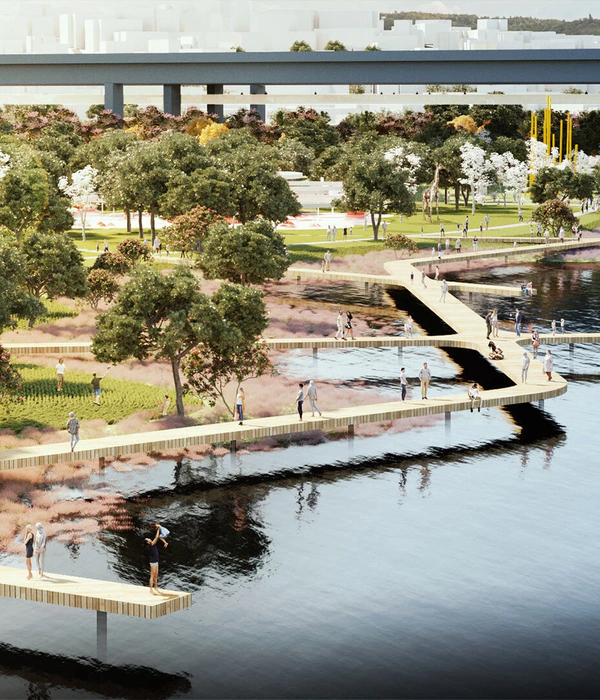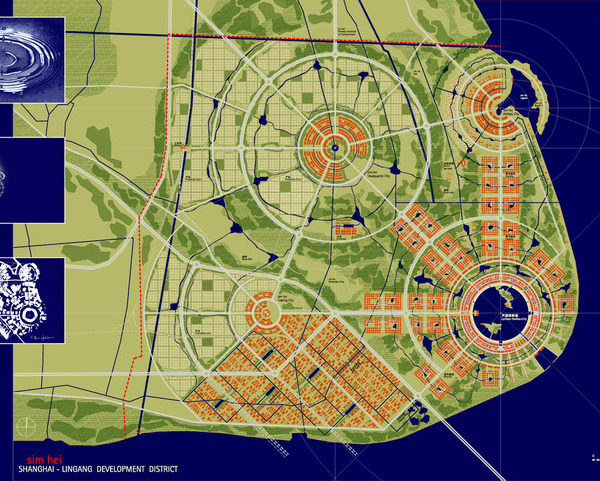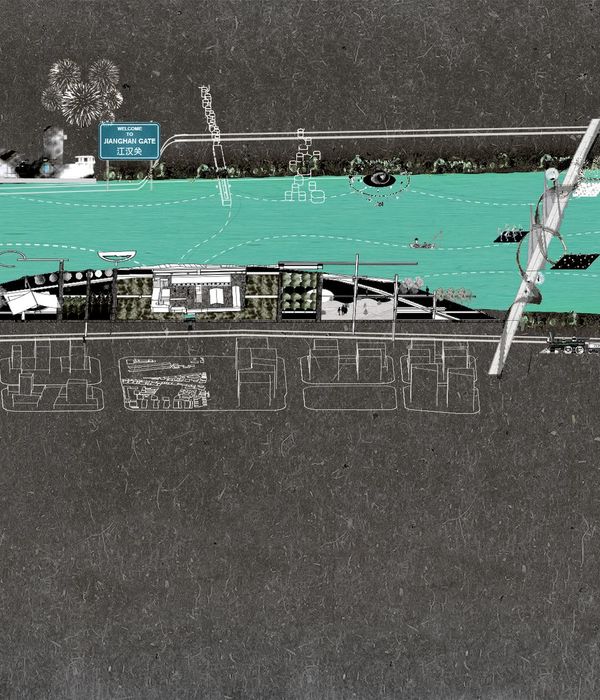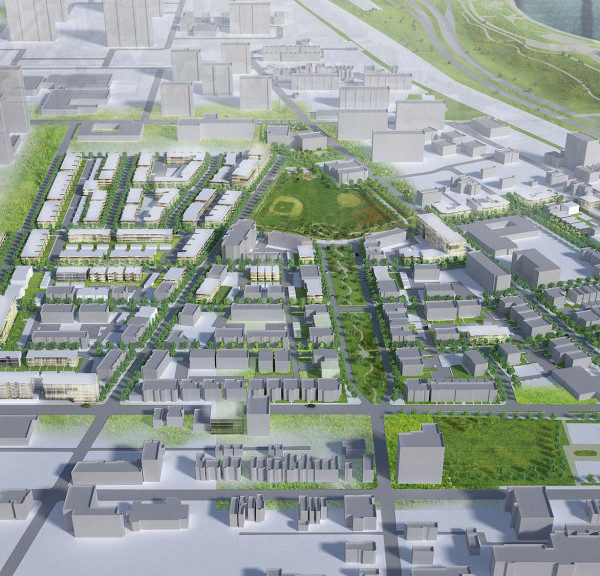来自
ASLA
Parsons Island Conservation and Regeneration Plan |
Mahan Rykiel Associates
项目概述
PROJECT STATEMENT
几百座岛屿已经消失于切萨皮克湾的水下。自1850年以来,这些岛屿涵盖了约10500英亩的栖息地,以及难记其数的宝贵文化遗产和古器物,其中部分可追溯至2万年前。土地下沉、海平面上升与海浪引起的侵蚀,不论是自然或是人为,均促进并加剧了正在发生的景观巨变。帕森斯岛保护和再生计划提出在切萨皮克湾的这处独特的岛屿上,将文化资源保护、栖息地再生和复原力增强的目标结合起来,使其成为催化集体行动和刺激具有影响力的管理的手段和方法。基于联邦政府资助的切萨皮克湾岛屿大规模恢复项目的背景,此项合作与适应性的工作为解决美国最大河口地区的珍贵岛屿的损失问题提供了一种新的方法。
Hundreds of islands have vanished beneath the waters of the Chesapeake Bay. Since 1850, this includes approximately 10,500 acres of island habitat as well as an unknown number of invaluable cultural and archaeological artifacts, some dating back 20,000 years. Land subsidence, rising sea level, and wave-induced erosion, both natural and anthropogenic all contribute to and compound this ongoing and accelerating landscape saga. The Parsons Island Conservation and Regeneration Plan proposes to collocate opportunities for cultural resource conservation, habitat regeneration, and resiliency enhancements on this unique Chesapeake Bay island as both a means and method to catalyze collective action and stimulate impactful stewardship. Considered within the context of large-scale, federally funded island restoration projects in the Chesapeake Bay, this cooperative and adaptive undertaking represents a new approach in addressing the loss of valuable islands in the nation’s largest estuary.
▲切萨皮克湾的一系列岛屿正在从水域之下消失,进而淹没了岛上的文化资源、栖息地和必要的景观基础设施。帕森斯岛位于肯特海峡以南3.5海里处,是马里兰州东部海湾仅存的岛屿。Disappearing Islands of the Chesapeake. Islands in the Chesapeake Bay are disappearing beneath its waters drowning cultural resources, habitats, and essential landscape infrastructure. Located 3.5 nautical miles south of Kent Narrows, Parsons Island is the only remaining island in Maryland’s Eastern Bay.
项目说明
PROJECT NARRATIVE
背景
帕森斯岛位于美国马里兰州安妮女王县、肯特海峡以南3.5海里处、切萨皮克湾大桥东南方向8.5英里处。根据欧洲定居者在1685年测绘的图纸,该岛现存78英亩的森林、农田、沼泽、开阔水域和宅地均是肯特岛441英亩的半岛区域的遗迹。1847年,该岛首次被描述为帕森斯岛,当时的面积为177英亩。不过,启蒙时期的欧洲历史并不足以让我们理解该岛的真正价值。史密森学会下属的考古学家在该岛受侵蚀的西南海岸线上发现的文物表明,帕森斯岛上的原始居民,其祖先在大约是在2万年前横跨大西洋,从法国中东部的梭鲁特地区迁移至此——这暗示了人类在北美大陆定居的一条新时间线和登陆路线。该岛丰富的历史和独特的文化资源同时也反映在其生机勃勃且多样的生态现状上,包括罕见的、被马里兰州自然资源部门指定为目标生态区的切萨皮克森林生境。岛上还包含潮汐湿地、海边泥滩、牡蛎沙洲、水下水生植被床以及农田,为留鸟和候鸟、哺乳动物、爬行动物、两栖动物、鱼类、节肢动物和软体动物提供了重要的生境。然而,帕森斯的生态资产和它的文化资源一样,因持续的侵蚀而处于危险之中。帕森斯岛的规模在不断缩小,文化和生态资源均受到威胁,但作为东部海湾仅存的岛屿之一,它的存在和延续仍起到了重要的基础服务作用,即作为弹性缓冲带,防止大风引起的巨浪以及气候导致的流域风暴事件。
为了确保帕森斯岛的文化、生态和复原力价值能够为切萨皮克湾的生境做出贡献,同时也让公众永久受益,该岛的所有者与切萨皮克保护协会,以及由景观设计师、工程师和研究人员组成的团队进行合作,共同制定了帕森斯岛的保护和再生计划。这项计划及其进程均是为了促进集体行动并刺激具有影响力的管理。该合作项目的核心是逐步实施加强帕森斯岛既有文化、生态和弹性资产的战略,同时为公众的使用、教育和休闲创造新的机会。
多重挑战
帕森斯岛面临的挑战是庞大且复杂的,但却有迹可循。在切萨皮克湾,海平面上升和土地下沉的共同作用导致每年相对的海平面上升高度为4.8-6.3毫米,接近全球平均数值(1.7毫米)的三倍。海湾水位的上升和土地的下沉,与大风和船只驱动的波浪共同形成了一个力的系统,使数百个岛屿不复存在。帕森斯从一个原本447英亩的岛屿急剧缩小至78英亩,这也是海湾内诸多岛屿所共同遭受的令人警醒的灾难。与此同时,经济和政治因素让以上这些环境挑战变得更为复杂,来自联邦和州的数十亿美元资金大都分配给了规模较大的项目,例如面积达到1000英亩以上的哈特-米勒岛、杨树岛和湾中岛的恢复项目,这也进一步剥夺了帕森斯这样的小型岛屿的恢复机会。帕森岛保护和再生计划旨在直接地应对这些复杂的环境、经济和政治挑战,同时将文化资源保护、生态改善、气候适宜以及复原力的提升整体地结合起来。
机会的整体配置
帕森斯岛为展示多功能景观干预措施的价值提供了独特的机会,这些措施旨在以集体合作的方式实现广泛的公共利益。将不同改善机会进行整体配置的策略阐明并利用了切萨皮克沿海环境中的厚重文化和生态关系网络——这些关系无一例外地受到了政治和经济的影响。虽然拥有各自独立的主题,并且受到不同州和联邦机构的监管,帕森斯岛的文化、生态和复原力价值始终是相互联系的。这些观念和物理上的联系构成了帕森斯岛保护和再生计划的基础,同时也为发展战略伙伴关系、制定规划框架和针对场地的设计策略提供了纽带。计划的目标是,通过将每个拟议的改造策略与一个与之相联系的增量投资系统绑定在一起,最终为所有三个主题带来积极的影响。
因此,帕森斯岛保护和再生计划优先考虑的是如何使用并简单地对既有的当地材料进行重新配置,以实现与环境紧密关联、成本效益高、模块化且可扩展的理想成果。该方法重点采用了在帕森斯岛或附近区域发现的三种材料类型——树枝、岩石和沉积物。倒下的树木,包括树干、树根和树枝,均已大面积遭受风和海浪的侵蚀,它们将被重新安置为“森林基石”(sylvan sills),一方面可以起到削弱海浪和捕捉沉积物的作用,另一方面也能为岛屿北岸区域提供新的水生生境。树枝的应用策略系现在两种不同的“森林基石”景观上:一种是在侵蚀程度较高的森林海岸上设置的木桩,另一种是在湿地和海水交汇处设置的柴笼。沿着西南侧的海岸线,强力的海浪侵蚀将岛上的远古人造物暴露出来,这里也是岩石应用策略的实施地点:重新使用和引入用乱石堆砌的护坡,为海岸提供保护,同时通过石阶和丰富的种植块来提升可达性并改善生境。石碓护坡将与承重的生态砖结合起来,在近海环境中创造一个活的防浪堤,旨在保护该岛免受持续的侵蚀,同时维持其文化资源的可见度,为公众教育和科普创造机会。沉积物应用策略旨在采用来自附近肯特海峡的疏浚材料。该水道必须每三年挖掘一次以保持航路的深度,其费用由该州纳税人承担,因为它不是一个有资格获得大量联邦资金的高运量航道。沉积物的重新利用将促进岛上部分原始区域的再生,包括新的泥滩、水下水生植被床(SAV beds)、潮汐沼泽和岛上森林等,使帕森斯岛的栖息地总面积从78英亩增加至145英亩。这将为东湾岛屿的背风面赋予更强大的复原力,并为维持更大范围的的沉积物平衡提供一种更加经济的方式。
以上这些策略将创造出一系列纹理丰富且性能优异的景观,彰显并加强岛屿的文化、生态和弹性资产。由步道和科普元素(包括海岸线小路、森林步道、农业步道和宅地几部分)组成的导览网络将把这些经典的、充满切萨皮克特征的体验编织在一起,营造出独一无二的公共景观,为该地区的保护和再生树立一个新的范例。
集体影响力的催化剂
以合作为基础的帕森斯岛保护和再生计划提供了一个可使多代人受益的机会,它将确保岛上珍贵的文化器物、重要的栖息地和景观基础设施永久地惠及公众。新置入的景观元素以及“有所为有所不为”的介入方式实现了令人满意的结果,这也促进了一个不断发展壮大的团体的诞生:保护主义者、研究人员、设计师、工程师和政府机构共同与帕森斯岛的所有者展开合作,逐步推进该计划的实施,并为集体行动建立了新的伙伴关系。实际的实施过程将与一系列相关行动同步进行,其最终结果也将受到监管、融资和技术因素的影响。帕森斯岛保护和再生计划以集体合作的方式实现了对海湾复杂的生态、经济和监管环境的控制,为该地区日益减少的小却富有价值的岛屿例举了“可以实施”(或应该实施)的举措,从而为未来的各种可能性奠定了基石。
▲从帕森斯角到帕森斯岛:帕森斯岛在1647年首次以“帕森斯角”的身份被记录。在风蚀、海浪、海平面上升以及土地下沉等因素的共同影响下,帕森斯岛的面积已从当初的447英亩缩小到78英亩。From Parsons Point to Parsons Island: Parsons Island, first documented as Parsons Point in 1647 at 447 acres has been reduced to 78 acres by forces including erosive wind and boat driven waves, rising sea levels, and land subsidence.
▲从东侧望向岛屿:自1969年以来,帕森斯岛的侵蚀率不断增加,危及到其未来的生存。在意识到这一威胁之后,该岛的所有者与切萨皮克保护协会以及由景观设计师领导的团队合作,制定了帕森斯岛的保护和再生计划。A View From the East. Since 1969, the erosion rate at Parsons Island has increased, jeopardizing its future. Recognizing this threat, the island’s owners partnered with the Chesapeake Conservancy and a landscape architect led team to develop the Parsons Island Conservation and Regeneration Plan.
▲场地特征:帕森斯岛现存的78英亩土地包括岛屿森林、农田、潮汐沼泽、开放水生态区域、受侵蚀的海岸悬崖,以及一处包含两座客人住宅和多栋外部建筑的宅地。Site Character. Parsons’ 78 extant acres includes island forests, agricultural fields, tidal marshes, open water ecologies, eroding coastal cliffs, and a homestead with two guest houses and out buildings.
▲文化:梭鲁特人假说。在帕森斯岛受到侵蚀的西南海岸线上发现的文化古器物表明,该岛的原始居民在大约2万年从法国的梭鲁特地区迁移至此,这暗示了人类在北美大陆定居的一条新时间线和登陆路线。Culture: The Solutrean Hypothesis. Cultural artifacts discovered on Parsons’ eroding southwestern shoreline indicate its original inhabitants arrived from the Solutré territory of France some 20,000 years ago – suggesting a new timeline and arrival route for human settlement on the North American continent.
▲生态:切萨皮克岛屿栖息地。帕森斯岛的生态包括罕见的切萨皮克岛屿森林生境、潮汐湿地、泥滩、牡蛎滩、水下水生植被床以及农田,为留鸟和候鸟、哺乳动物、爬行动物、两栖动物、鱼类、节肢动物和软体动物提供了重要的生境。Ecology: Chesapeake Island Habitats. Parsons Island ecologies include rare Chesapeake Island forest habitat, tidal wetlands, mudflats, oyster bars, submerged aquatic vegetation (SAV) beds, and farm fields that serve as critical habitat for resident and migratory birds, mammals, reptiles, amphibians, fish, arthropods, and mollusks.
▲恢复力:作为东部海湾仅存的岛屿之一,帕森斯岛的存在和延续起到了重要的基础服务作用,即作为弹性缓冲带,防止大风引起的巨浪、气候导致的风暴事件以及相对海平面上升(RSLR)。Resiliency: The Last Island Standing. As one of the only islands remaining in Eastern Bay, Parsons’ persistence provides an essential infrastructural service as a resiliency buffer against wind-induced waves, climate generated storm events, and relative sea level rise (RSLR) in the basin.
▲目标和策略:帕森斯岛保护和再生计划提出利用既有的、或是来自当地的树枝、岩石和沉积物来创建景观,将文化资源保护、栖息地再生和恢复力提升等目标结合起来,以推进与环境紧密关联、成本效益高、模块化且可扩展的设计策略。Goals & Strategies. The Parsons Island Conservation and Regeneration Plan proposes to collocate opportunities for cultural resource conservation, habitat regeneration, and resiliency enhancements using existing and/or local sticks, stones, and sediment to advance contextually-relevant, cost effective, modular, and scalable design strategies.
▲树枝:倒下的树木,包括树干、树根和树枝,均已大面积遭受风和海浪的侵蚀,它们将被重新安置为“森林基石”(sylvan sills),一方面可以起到削弱海浪和捕捉沉积物的作用,另一方面也能为岛屿北岸的水生生境提供支持。Sticks | Fallen trees including trunks, roots wads, and branches that have succumbed to erosion will be relocated and reconfigured to create ‘sylvan sills’ that attenuate waves, catch sediment, and support aquatic habitat in the island’s northern nearshore environment.
▲岩石:在西南海岸,既有的护坡将被延长,并与新的石阶和道路相连,以提供通往岛屿文化资源的路径,同时保护离岸的防浪堤、支持水生生境并削减波浪。Stones | On the southwestern shore, existing riprap will be extended and tied into a new stone stair and path providing access to and preserving the island’s cultural resources with an offshore living breakwater that supports aquatic habitat and enhanced wave attenuation.
▲沉积物:来自肯特海峡水道的疏浚材料将被重新利用,通过活体护堤、薄层放置、活体海岸线和受监测的自然恢复过程来创造新的泥滩、水下水生植被床、沼泽和岛屿森林,从而实现岛上部分原始区域的再生。Sediment | Dredged material from the Kent Narrows waterway will be repurposed to regenerate a portion of the island’s original footprint with living berms, thin layer placement, living shorelines, and monitored natural recovery creating new mudflats, SAV beds, marshes, and island forest.
▲保护和再生计划:实际的实施过程将与一系列相关行动同步进行,其最终结果也将受到监管、融资和技术因素的影响。第一阶段为西南部、第二阶段为南部和东部;第三阶段为北部;第四阶段为宅地区域。Conservation & Regeneration Plan. Plan implementation is anticipated to occur in parallel phases with simultaneous actions and asynchronous outcomes influenced by regulatory, financing, and technical drivers. Phase One Southwest; Phase Two South and East; Phase Three North; Phase Four Homestead.
▲计划要素:帕森斯岛保护和再生计划提出的策略将创造出一系列纹理丰富且性能优异的景观,彰显并加强岛屿的文化、生态和弹性资产。Plan Elements. The integrated stick, stone, and sediment strategies of the Parsons Island Conservation and Regeneration Plan will create a series of richly textured and high performing landscape elements that reveal and enhance the islands cultural, ecological, and resiliency assets.
▲岛屿北部:两种类型的“森林基石”、原木障碍物和柴笼将在北岸的湿地和开阔水域之间构成界面,以削弱波浪、捕捉沉积物并提供新的水生栖息地。这些栖息地可以从水面或森林小径开始探索。Northern Island. Two types of ‘sylvan sills’, log jams and fascinces will interface between wetlands and open water on the northern shores attenuating waves, catching sediment, and providing new aquatic habitat that can be explored from the water or forested paths.
▲岛屿南部:由步道和科普元素(包括海岸线小路、森林步道、农业步道和宅地几部分)组成的导览网络将把这些经典的、充满切萨皮克特征的体验编织在一起,营造出独一无二的公共景观,为该地区的保护和再生树立一个新的范例。Southern Island. A connected trail network and interpretive elements through rich habitats including shoreline paths, forest walks, agricultural roads, and a homestead loop will create a quintessentially Chesapeake experience that sets a new precedent for conservation and regeneration in the region.
PROJECT NARRATIVE
CONTEXT
Parsons Island, located in Queen Anne’s County, Maryland is 3.5 nautical miles south of Kent Narrows and 8.5 miles southeast of the Chesapeake Bay Bridge. The Island’s 78 extant acres of forests, fields, marshes, open water, and a homestead are what remains of a 441-acre peninsula of Kent Island mapped by European settlers in 1685 and first described as Parsons Island in 1847 at 177 acres. However, this Enlightenment-Era European history does not suffice in understanding the island’s true value. Artifacts discovered by a Smithsonian affiliated archaeologist along the Island’s eroding southwestern shoreline indicate that Parsons’ original inhabitants were pre-native people whose origins span the Atlantic Ocean to the Solutré territory of east-central France some 20,000 years ago – suggesting a new timeline and arrival route for human settlement on the North American continent. The island’s rich past and unique cultural resources are mirrored by its vibrant and textured ecological present and includes rare Chesapeake Island forest habitat designated as a targeted ecological area by the Maryland Department of Natural Resources. The island also includes tidal wetlands, mudflats, oyster bars, submerged aquatic vegetation (SAV) beds, and farm fields that serve as critical habitat for resident and migratory birds, mammals, reptiles, amphibians, fish, arthropods, and mollusks. Like its cultural resources, however, Parsons ecological assets are at risk due to its continued erosion. Yet despite its diminished size and threatened cultural and ecological resources, as one of the only islands remaining in Eastern Bay, Parsons’ presence and persistence continues to provide an essential infrastructural service as a resiliency buffer against wind-induced waves and climate generated storm events in the basin.
To ensure that Parsons Island’s cultural, ecological, and resiliency values not only continue to contribute to life in the Chesapeake, but also benefit the public in perpetuity, the Island’s owners partnered with the Chesapeake Conservancy and a team of landscape architects, engineers, and researchers to develop the Parsons Island Conservation and Regeneration Plan for the property. Both the plan and the planning process were structured to catalyze collective action and stimulate impactful stewardship. Central to this cooperative undertaking is incremental implementation and strategic enhancements to Parsons Island’s existing cultural, ecological, and resiliency assets, as well as the creation of new opportunities for public access, education, and recreation.
COMPOUND CHALLENGES
The challenges facing Parsons Island are considerable and compound, but not unique. In the Chesapeake Bay, rising sea levels and land subsidence indicate a relative sea level rise of between 4.8mm – 6.3mm annually; close to three times the global average of 1.7mm per year. The rising waters and subsidence of land in the Bay, combined with wind and boat-driven waves create a system of forces that have effectively erased hundreds of islands from existence. The dramatic reduction of Parsons from a 447-acre point to a 78-acre island is a sobering story shared by many, now lost, islands within the Bay. Further compounding these environmental challenges are the economic and political forces that align to allocate and appropriate billions of dollars of federal and state funding to mega projects that target island restoration efforts on the magnitude of 1,000+ acres like Hart-Miller Island, Poplar Island, and the Mid-Bay Islands projects, which leaves scant resources for more modest island restoration projects like Parsons. The Parsons Island Conservation and Regeneration Plan responds directly to these compound environmental, economic, and political challenges by collocating opportunities for cultural resources conservation, ecological uplift, and climate adaptation and resiliency.
COLLOCATING OPPORTUNITIES
Parsons Island provides a unique opportunity to demonstrate the value of a multi-functional collection of landscape interventions designed to work together to achieve wide ranging public benefits. This strategy of collocating opportunities for enhancements also illuminates and leverages the thickly tethered network of cultural and ecological relationships present within the coastal environments of the Chesapeake – relationships that are invariably influenced by politics and economics. While considered separate subject matters and regulated by a myriad of state and federal agencies, the cultural, ecological and resiliency value of Parsons Island are all linked to one another. These conceptual and physical linkages are the foundation of the Parsons Island Conservation and Regeneration Plan and provide the nexus for development of strategic partnerships, planning frameworks, and site specific design strategies that aim to positively affect all three subjects by positioning each proposed modification within an interconnected system of incremental investments.
The Parsons Island Conservation and Regeneration Plan thus prioritizes the use and simple reconfiguration of existing local materials to achieve desirable outcomes that are contextually-relevant, cost effective, modular, and scalable. This approach focuses on three primary material types found on or adjacent to Parsons Island – sticks, stones, and sediments. Fallen trees including trunks, roots wads, and branches that have succumbed to wind and wave driven erosion will be relocated and reconfigured as ‘sylvan sills’ serving as wave attenuating and sediment catching features that also provide new aquatic habitat in the nearshore of the northern portion of the island adjacent to the existing stand of forest habitat and wetlands where wave energy and erosive forces are at their lowest. This stick strategy includes two types of ‘sylvan sills’ – log jams for the more highly eroded stretches of forested shoreline and fascines for the interface between wetlands and water. Along the southwestern shoreline where high intensity waves and erosion have exposed the islands pre-native artifacts for discovery, a stone strategy includes riprap, both repurposed and introduced, that will provide not only coastal protection, but also opportunities for accessibility and habitat enhancements via stone stairs and textured planting pockets. Riprap and engineered ecoblocks will also be combined to create a living breakwater in the offshore environment that aims to protect the island from continued erosion while preserving the visibility of its cultural resources and creating opportunities for public education and interpretation. Parsons’ sediment strategy will leverage dredged material from the nearby Kent Narrows waterway, which must be excavated every three years to maintain navigable depths at the expense of state taxpayers because it is not a high-volume shipping channel eligible for large federal funding. Repurposing this sediment to regenerate a portion of the island’s original footprint including new mudflats, SAV beds, tidal marshes, and island forest will nearly double the total acreage of habitat at Parsons from 78 acres to 145 acres, provide enhanced coastal resilience for land leeward of the island in Eastern Bay, and offer a cost-effective way to manage local sediment balances in the larger basin.
These integrated stick, stone, and sediment strategies will create a series of richly textured and high performing landscapes that reveal and enhance the islands cultural, ecological, and resiliency assets. A network of connected trails and interpretive elements including shoreline paths, forest walks, agricultural roads, and a homestead will weave together these quintessentially Chesapeake experiences creating a one-of-a-kind public landscape that sets a new precedent for conservation and regeneration in the region.
A CATALYST FOR COLLECTIVE IMPACT
The ambitious and collaborative Parsons Island Conservation and Regeneration Plan presents a generational opportunity to ensure the island’s priceless cultural artifacts, vital habitats, and essential landscape infrastructure benefit the public in perpetuity. The importance of these features and the consequences of doing nothing have catalyzed an evolving and growing group of conservationists, researchers, designers, engineers, and government agencies who are working together with the property owners of Parsons Island to advance the plan incrementally and establish new partnerships for collective action. Plan implementation is anticipated to occur in parallel phases with simultaneous actions and asynchronous outcomes influenced by regulatory, financing, and technical drivers. The Parsons Island Conservation and Regeneration Plan lays a groundwork of possibilities by collaboratively navigating the complex ecological, economic and regulatory context of the bay and setting an example for what could (and perhaps should) be done with the dwindling number of small, yet valuable, islands in the region.
{{item.text_origin}}












